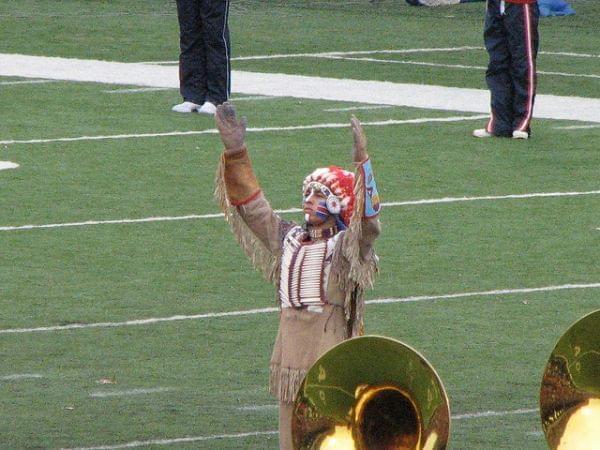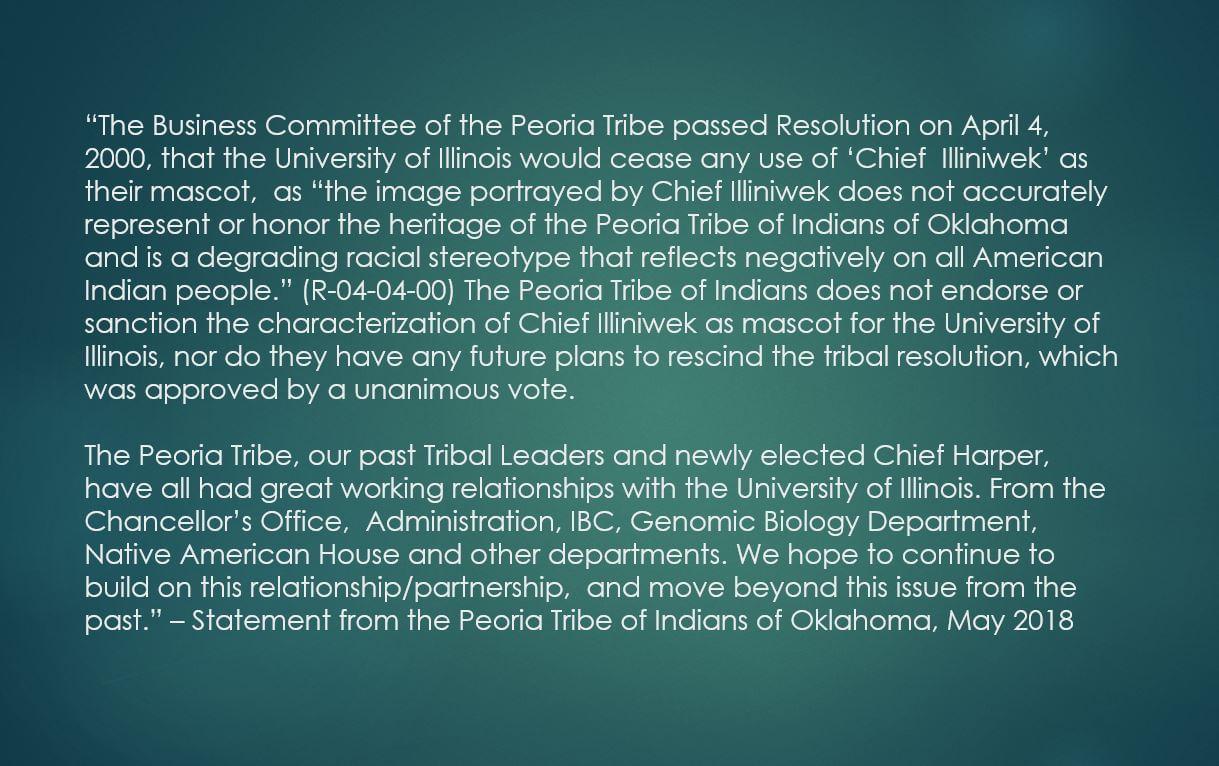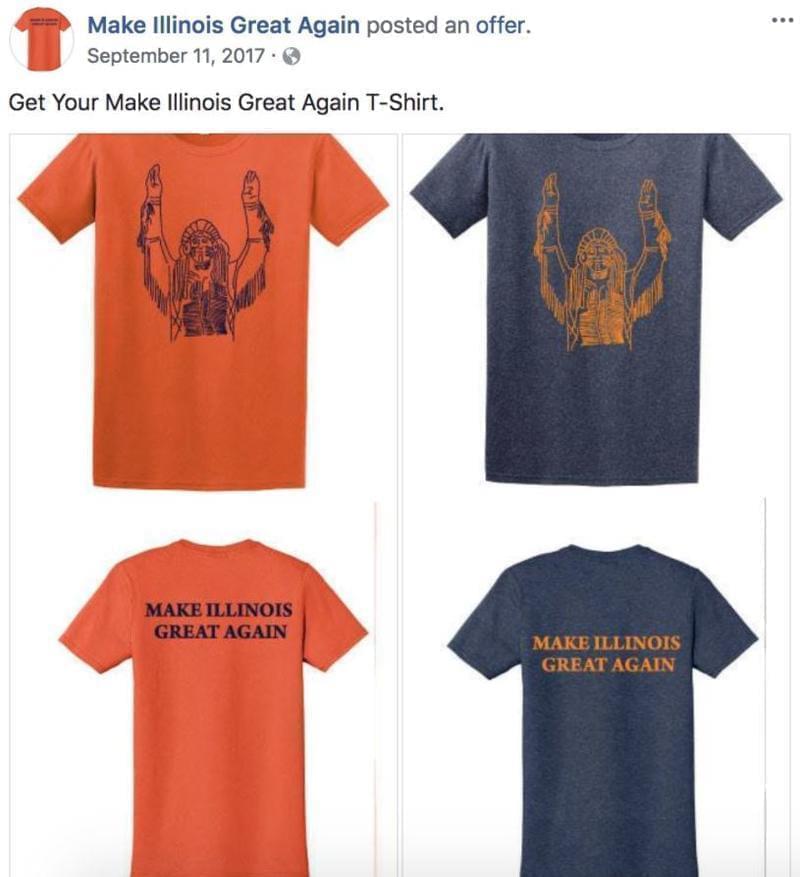Reporter Takes Deep-Dive Into Illini Country In Search Of Chief

U of I marching band and Chief Illiniwek portrayer - taken on November 11, 2006 flickr/soundfromwayout
Chris Quintana covers the "culture wars" on college campuses and other news for The Chronicle of Higher Education. He was intrigued by the story of the University of Illinois Urbana-Champaign's one-time icon, Chief Illiniwek. Quintana visited the school and surrounding area for a story released earlier this year.
Chief Illiniwek was officially retired in 2007. But as Chris Quintana discovered, he never really went away. Chief's ongoing presence is something that's been covered before - but it remains a point of contention on campus.
In recent weeks the university has hosted conversations meant to help bridge the divide between Chief Illiniwek supporters and those who would rather see his presence left to the pages of a history book. Chancellor Robert Jones told Quintana he would not entertain the idea of the mascot regaining entry to official campus culture.
The mascot, which supporters argue was a "symbol" - not a mascot, got its start in the 1920s. While there was never a person with the Illiniwek name, there was a confederation of Illinois tribes he is said to represent. Over the past year, the controversy surrounding the mascot has included alleged filming in a bathroom, a lawsuit over an alum using the image of the chief with the words "Make Illinois Great Again," and proposals for revising university protest policies.
Quintana joined NPR Illinois for a conversation about what he learned during his reporting on the issue earlier this year. The conversation has been edited for length and clarity.
Rachel Otwell: The chief was retired in 2007 because of a ruling from the NCAA. But this is still an issue, and the university recently hosted a series of conversations about it. The chancellor told you, Chris, that the symbol of Chief Illiniwek is not coming back. But in a way - the chief never really left, right?
Chris Quintana: Right. It's funny that you mentioned the 2007 decision because the university recognized his departure in this big formal dance, and it was broadcast. There were a lot of fans who were sad at his departure. But the very next year, fans of Chief Illiniwek put on another dance. There wasn't even like an interruption from 2007 to 2008. All that changed was that the university's backing wasn't there anymore, but this dance was still hosted at the university. I think to the casual observer, you'd be like, 'Did he even ever go away?'
You walk around the campus, you walk in Champaign, and you can find evidence of the chief pretty much wherever you go. The one that was clearest to me was at this bar, Legends. You've got a glass case with full scale Chief Illiniwek regalia there on display. So I think you'd be forgiven if you thought that the chief was never really officially retired.

The Peoria Tribe of Indians of Oklahoma was deemed the closest resembling tribe to Chief Illiniwek by the NCAA. They would have to grant permission for the mascot to be used. After hearing some Illini fans hold onto hope they may change their decision - NPR Illinois reached out for comment and received this statement in response.
Ivan "Alex" Dozier, a University of Illinois alum, says he is of Cherokee ancestry. He was one of the more recent "unofficial chiefs" from 2010 to 2015. There are multiple groups that exist and say they want to uphold the legacy of Chief Illiniwek. Dozier was part of an incident where a professor who made a documentary back in the nineties about Native American imagery in sports allegedly filmed him and his father as they got a chief portrayer ready in his costume during a basketball game. Can you remind us about that controversy?
This controversy is between Ivan "Alex" Dozier, his father and Jay Rosenstein, who is this noted documentarian who made this film "In Whose Honor," which is this a examination of Native American mascots. It focuses on Charlene Teters, who at the time was a Native American student at the University of Illinois. The film follows her as she explains why she finds the symbol offensive, and he talks to members of the community who don't find the symbol offensive. All of which is to say, Rosenstein's very ingrained in the community.
This is something he's been doing for a long time. He's been leading kind of an active charge against the use of Native American mascots through his work and through his activism. And so Jay said, at the time, that he had gone to the State Farm arena to try and capture evidence of collusion between the staff.
I'm not exactly sure who would be colluding with whom, but the thought was that there was some kind of cooperation between university employees or contractors with the Doziers to allow for this person to wear the Chief Illiniwek regalia. What he told me was he was trying to capture evidence of collusion. As for claims he was filming in a bathroom - there's a lot of implications to that. Ivan (Jr.) described him at the time as trying to catch him with his pants down, although he later walk that back a little bit. But that really blew up.
I recently spoke with Ivan "Alex" Dozier. Here is a portion of what had to say:
"I think it's important to recognize just how nuanced this issue really is. Let's not lump things together. Let's not say that all Native imagery in athletics is good or that all Native imagery in athletics is bad.I think we need to treat each of these issues on an issue by issue basis. We need to understand the cultural foundation that led to the creation of the symbolism, and we need to understand how people are using and reacting to this imagery when it's presented to them in their own communities."
Last year I spoke with Thereza Lituma, who at the time was president of the Native American and Indigenous Student Organization. She spoke about a regular drive they do to collect shirts with the chief logo and image. Here's some of what she had to say :
"To see your culture being displayed for entertainment at a sports game is absolutely disgusting to me. I know that a lot of people have the perspective that they learn about Native American culture through seeing that, but that doesn't make any sense to me because you shouldn't be learning about Native American culture in a sports arena. There are so many ways that you can go into Native American culture. But to have a guy dressed up in regalia and that's who our mascot is - it's disgusting, for me personally."
Chris - do you think these two voices summarize the debate that continues?
I think that's pretty much the summation of the two viewpoints. You have your Ivans who see the image as a way to honor the Native American culture, and then you have people who are Native and people who are sensitive to the use of Native American imagery saying it's appropriative and it portrays them in a negative light -- that it dehumanizes or flattens them into a stereotype. So I would say that's pretty representative of what I've found in my reporting.

The shirt that inspired a lawsuit.
Protests have continued to happen in recent years, even in recent months. At the end of the day, why doesn't the university find a new name or a new symbol or mascot? Were you able to really get a sense of whether or not the university is willing to move past this and leave it behind, and why or why not?
In reporting this story, I was told by a couple of people that the hope had been when they retired the chief in 2007 that they would cycle out the current class of undergraduates and in four years this wouldn't be a problem. But I think, as the the last official chief portrayer Dan Maloney told me, this is widespread in Illinois. It has really deep roots there. I think part of the challenge in adopting a new name is -- do you then alienate this kind of entire system that is there?
"They want a new mascot. They want something new to hold onto, and I think the student body wants that too." - Chris Quintana
I don't know what the answer is to that. Chancellor Robert Jones told me that adopting a new mascot or adopting a new logo or whatever the case may be, that it wouldn't be a panacea to fix the problem. He feels that there needs to be kind of reckoning, an acceptance of what has changed and what will not be returned to. And he told me that he doesn't feel like that ever really happened in 2007. I think that's part of the calculus, but increasingly among the anti-chief folks, that's really what they want. They want a new mascot.
They want something new to hold onto, and I think the student body wants that too. I think students want something that they can latch onto in the void of a new mascot, based on what I've been told by people who are against the chief. The default has been to go to Chief Illiniwek.
Read Quintana's full report here. NPR Illinois would like to express thanks to The Chronicle of Higher Education for providing a publicly accessible link to this story.
Illinois Issues is in-depth reporting and analysis that takes you beyond the headlines to provide a deeper understanding of our state. Illinois Issues is produced by NPR Illinois in Springfield.
Links
- THE HISTORY OF CHIEF ILLINIWEK
- ‘Critical Conversations’ Events Aim To Bridge Divide Over Chief Illiniwek
- Chief Illiniwek Controversy Surrounds Homecoming Parade
- Chief Illiniwek Controversy Carries On; Gubernatorial Candidate Chris Kennedy
- Native American Student’s Online Comments Opposing Chief Illiniwek Lead To Rally

